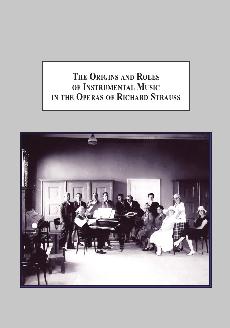The Origins and Roles of Instrumental Music in the Operas of Richard Strauss: From Concert Hall to Opera House
We are currently unable to ship to the EU countries at this time. We apologize for this inconvenience.

| Author: | Rowat, Malcolm | |
| Year: | 2012 | |
| Pages: | 252 | |
| ISBN: | 0-7734-3078-4 978-0-7734-3078-5 | |
| Price: | $199.95 + shipping | |
| (Click the PayPal button to buy) | ||
The main purpose of this volume is to provide an overview to all of Richard Strauss’s musical and operatic compositions. Usually the operas are ignored by scholars and composers who only perform his instrumental works. This book shows that there is incredible musical value in the operas as well. It also showcases his compositional style and techniques, as the author states, Strauss could compose while riding on a noisy train, he was just that talented.
Because of his involvement with the Nazi Party, Richard Strauss has been ignored by musical scholars for quite some time. Even when he is studied his operas are often viewed as being less important than his instrumental works. This book remedies that misconception by addressing how his operas were created and pin pointing the musical importance by chronicling their compositional qualities. There is also quite a bit about Strauss’s life in this book as well.
Because of his involvement with the Nazi Party, Richard Strauss has been ignored by musical scholars for quite some time. Even when he is studied his operas are often viewed as being less important than his instrumental works. This book remedies that misconception by addressing how his operas were created and pin pointing the musical importance by chronicling their compositional qualities. There is also quite a bit about Strauss’s life in this book as well.
Reviews
“A much needed book on Strauss. For the first time he brings into clear focus two of the most important things about the magnificent composer: his fabulous talent for instrumental music and his talent for opera.”
-Prof. John Deathridge,
King’s College, London
“The book is an admirable and engaging appraisal of Strauss’s work that focuses on the role of the orchestra, particularly in the operas.”
- Dr. Leon Botstein
Bard College
“Rowat takes a refreshingly different view…Readers wanting a concise overview to the composer’s major works will find this book helpful.”
- Prof. Lawrence Kramer,
Fordham University
-Prof. John Deathridge,
King’s College, London
“The book is an admirable and engaging appraisal of Strauss’s work that focuses on the role of the orchestra, particularly in the operas.”
- Dr. Leon Botstein
Bard College
“Rowat takes a refreshingly different view…Readers wanting a concise overview to the composer’s major works will find this book helpful.”
- Prof. Lawrence Kramer,
Fordham University
Table of Contents
Foreword by John Deathridge
Chapter 1: Prologue
Controversial Musical and Personal Background
Purpose and Scope of Book
Chapter 2: Antecedents to Strauss’s Personal and Musical Development
Strauss’s Early Years
Chapter 3: The Road to Modernism
Chapter 4: First Cycle
Macbeth
Don Juan
Tod and Verklärung
Chapter 5: The Initial Bridge to Opera – Guntram
Chapter 6: The Role of Instrumental Music in Opera
Chapter 7: Second Cycle of Tone Poems
Till Eulenspiegel
Also Sprach Zarathustra
Don Quixote
Ein Heldenleben
Chapter 8: Return to the Opera House
Chapter 9: Tone Poem Interlude
Chapter 10: Operatic Breakthrough
Chapter 11: The Genesis of a Major Collaboration
Origins of the Opera Elektra
Strauss’s Musical Adaptation
Chapter 12: Return to Mozart?
Chapter 13: Building on an Operatic Success
Chapter 14: The Ballet Diversion
Chapter 15: The Last Tone Poem?
Chapter 16: Ariadne Revisited
Chapter 17: Deepening Collaboration
Chapter 18: On His Own
Ballet Initiative
Personal Marriage Opera
Chapter 19: Collaboration Reunited
Arabella
Chapter 20: Operatic Interlude
Chapter 21: The Gathering Storm
Chapter 22: Into the Darkness
Friedenstag
Daphne
Die Liebe der Danae
Chapter 23: Opera for Connoisseurs
Chapter 24: War and its Aftermath
Chapter 25: Final Thoughts
The Tone Poem Legacy
Nature of Instrumental Music in Opera
Importance of Librettos as Inputs
Forays into Ballet and Dance
Penetrating the Enigma of Strauss the Man
Chapter 26: Epilogue
Bibliography
Index
Chapter 1: Prologue
Controversial Musical and Personal Background
Purpose and Scope of Book
Chapter 2: Antecedents to Strauss’s Personal and Musical Development
Strauss’s Early Years
Chapter 3: The Road to Modernism
Chapter 4: First Cycle
Macbeth
Don Juan
Tod and Verklärung
Chapter 5: The Initial Bridge to Opera – Guntram
Chapter 6: The Role of Instrumental Music in Opera
Chapter 7: Second Cycle of Tone Poems
Till Eulenspiegel
Also Sprach Zarathustra
Don Quixote
Ein Heldenleben
Chapter 8: Return to the Opera House
Chapter 9: Tone Poem Interlude
Chapter 10: Operatic Breakthrough
Chapter 11: The Genesis of a Major Collaboration
Origins of the Opera Elektra
Strauss’s Musical Adaptation
Chapter 12: Return to Mozart?
Chapter 13: Building on an Operatic Success
Chapter 14: The Ballet Diversion
Chapter 15: The Last Tone Poem?
Chapter 16: Ariadne Revisited
Chapter 17: Deepening Collaboration
Chapter 18: On His Own
Ballet Initiative
Personal Marriage Opera
Chapter 19: Collaboration Reunited
Arabella
Chapter 20: Operatic Interlude
Chapter 21: The Gathering Storm
Chapter 22: Into the Darkness
Friedenstag
Daphne
Die Liebe der Danae
Chapter 23: Opera for Connoisseurs
Chapter 24: War and its Aftermath
Chapter 25: Final Thoughts
The Tone Poem Legacy
Nature of Instrumental Music in Opera
Importance of Librettos as Inputs
Forays into Ballet and Dance
Penetrating the Enigma of Strauss the Man
Chapter 26: Epilogue
Bibliography
Index
